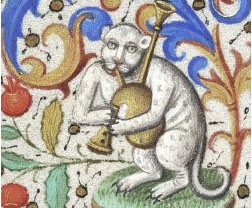Have you ever seen medieval paintings of cats? Some highly entertaining examples are making the rounds on social media. As comical as they might be, they underscore a truth: for centuries, cats’ lives have been deeply interwoven with our own. And naturally, they’ve appeared in our music! In honor of the quirky holiday called National Hug Your Cat Day on June 4, here’s a lighthearted look at some feline-inspired music.
There are some doubts about whether “The Cat Duet” was actually composed by Gioachino Rossini, as originally thought, or by an unnamed composer in 1825. Called playful, lively, and even comical, this vocal duet imitates a cat “conversation” and is sure to entertain fans of felines. Check out a performance here.
In 1943, Benjamin Britten was asked to set a religious poem called “Jubilate Agno” (“Rejoice in the Lamb”) to music. He created a cantata for the poem, which was written by Christopher Smart and included lines about Jeoffrey, Smart’s cat, whom he calls “the servant of the Living God duly and daily serving him.” Smart waxes eloquently about his furry friend, including these lines:
For first he looks upon his forepaws to see if they are clean.
For secondly he kicks up behind to clear away there.
For thirdly he works it upon stretch with the forepaws extended.
For fourthly he sharpens his paws by wood.
For fifthly he washes himself.
Britten was asked to remove the bit about Jeoffrey but declined, saying, “He is such a nice cat.”
Another musical work based on a poem is Samuel Barber’s “The Monk and His Cat.” W. H. Auden adapted a ninth-century Old Irish poem, a loving ode from a monk to his white cat, which Barber set to music for his 1953 album “The Hermit Songs, Op. 29.” Listen to Leontyne Price’s performance of the piece here.
Igor Stravinsky wrote “Cat Lullabies” in 1914. But the last original work he ever completed also featured a whiskered character: “The Owl and the Pussy-Cat.” Based on Edward Lear’s poem of the same name, he dedicated the piece to his wife, Vera. To him, the music was a “sigh of release.”
Lest you thought the famous musical “Cats!” was the only work in which every character is feline, consider Hans Werner Henze’s “The English Cat.” In this opera, written in the early 1980s but set in 1890s London, a group of middle-class cats forms the Royal Society for the Protection of Rats. Described as a dark comedy, the plot contains all the essential drama of a great opera: questionable relatives, ill-fated love, murder, and intrigue. Check it out here.
Enjoy these whimsical compositions, and don’t forget to hug your cat!

